Hospes Las Casas del Rey de Baeza, Sevilla
last update: 1 January 2023
Finding the hotel
In May 2022 we stayed at Hospes Palacio de Arenales & Spa, very near Cáceres. This hotel is part of a network of 9 Hospes Hotels, so in December 2022 we decided to try two of the other hospes.
So for our trip back down to Spain we decided to stay at Hospes Palacio de San Esteban in Salamanca, and Hospes Las Casas del Rey de Baeza in Sevilla.
The Latin origin of hospes was simply "host" or guest", but could just as easily be stranger or foreigner. It appears to be at the origin of hospital, hostel, hospitality, etc., or a place in which a relationship was established and developed between individuals. It certainly also took on the meaning of a place of refuge for weary or sick travellers seeking a moment of rest on life's journey.
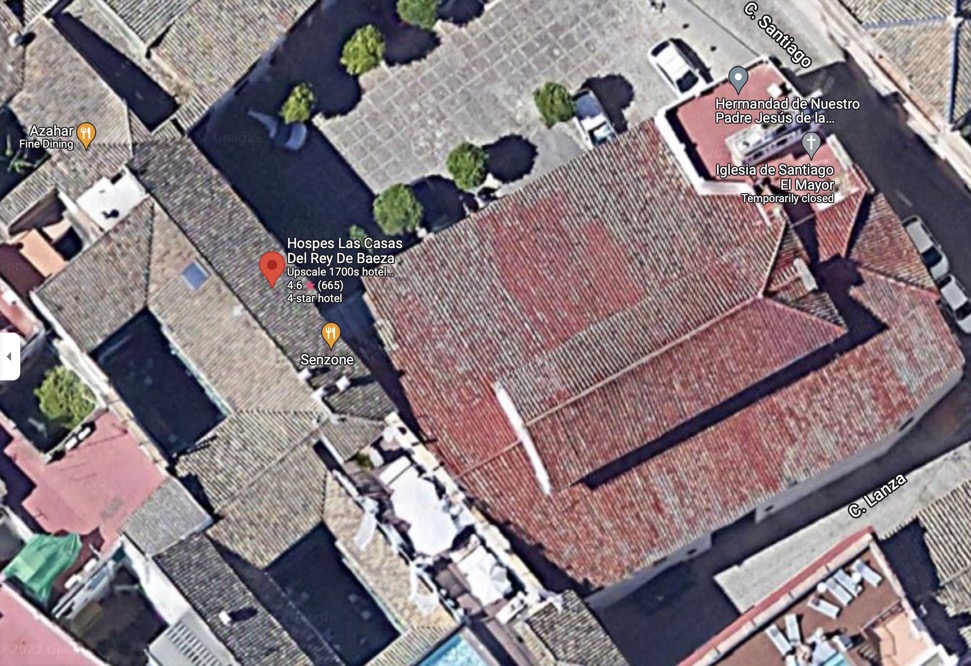
In preparing our visit we had a number of exchange with the hotel (hospes) about:-
Parking, they have an underground parking but we had to check if it could accommodate a car longer than 5 meters. The problem was the turning circle to enter and leave the underground parking, but in the end there was no problem (there is only space for a small number of cars).
Walk-in shower, there were a few options, but many of the rooms appeared to only have a large round bathtub, with a shower attachment.
Food, we were looking for room service on the 24th and 25th December, when traditionally hotels are offering set menus with a multitude of courses. Initially we were offered a fixed menu for dinner on the 24th and lunch on the 25th. Then it turned out they were fully booked anyway. Finally they arranged for a limited menu to be pre-booked and served in our room on the evening of the 24th (at 20:00), and normal room service was resumed on the 25th December. We saw that the hotel had a single enormous table set for both dinner on the 24th and lunch on the 25th.
It must be said that the hotel was very accommodating, and we found a comfortable solution to all our questions.
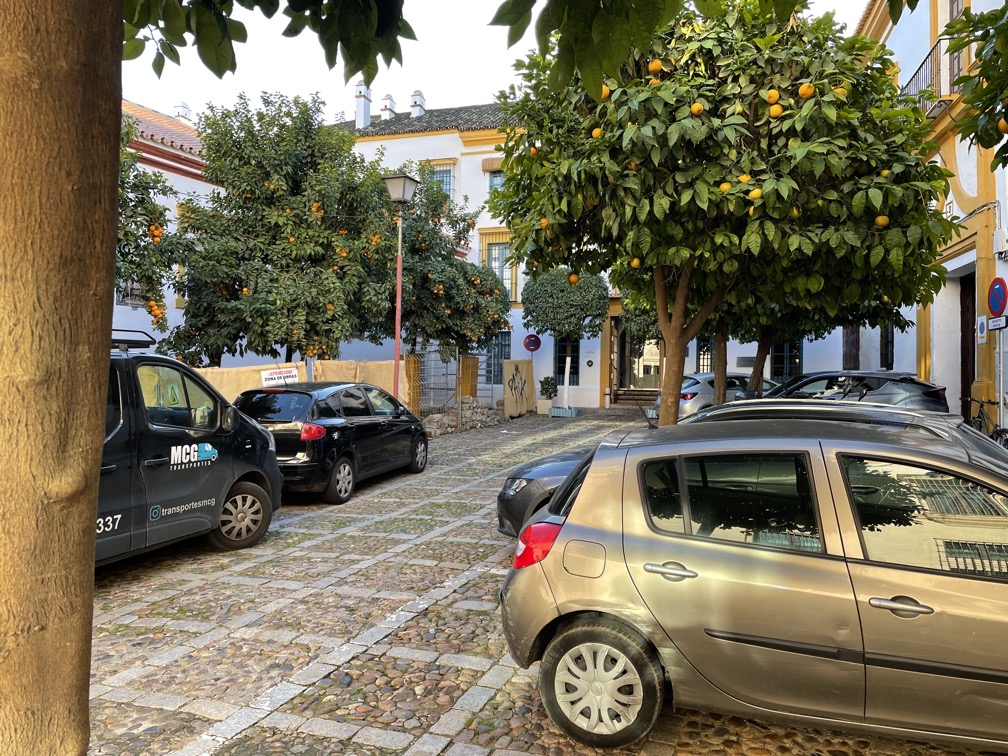
The hotel address Plaza Jesús de la Redención, 2, is really just a small parking area on Calle Santiago, but our car navigation system found it with ease. Seville is a difficult place to drive through, so its important to have an up-to-date GPS system, e.g. both our car navigator and TomTom often produced different routes, but both led to the same destination. The roads are narrow, and parking is impossible, so it was important to be able to drive up to the entrance of the hotel (if only for a few moments).
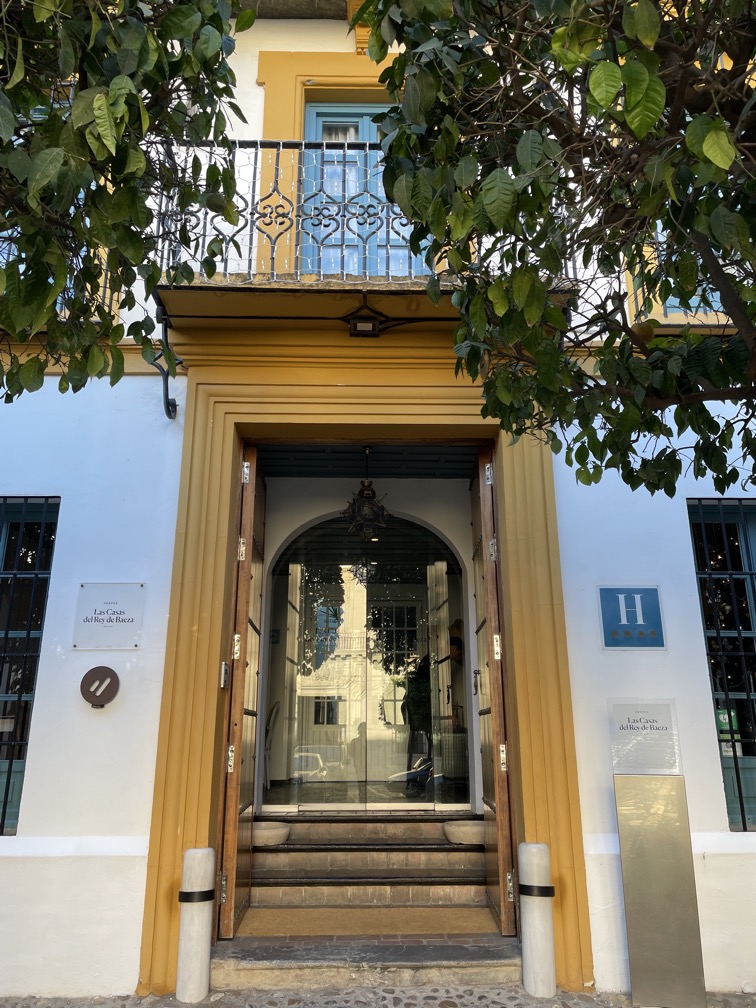
We were happy to find a porter who parked our car in the underground garage, and took us and our bags up to our rooms. Our car was always accessible in the underground garage at -1.
Reception and hotel public spaces
It's difficult to visualise the hotel that is sitting behind the façade presented above. Clearly the expectation is of a traditional hotel, but what you find is in fact a set or rooms mostly accessed from balconies and stairwells set around a number of courtyards. I think there were three or possible four courtyards as part the hotel, but I'm not sure how many rooms were accessed from them. It looked as if there were two principle courtyards.
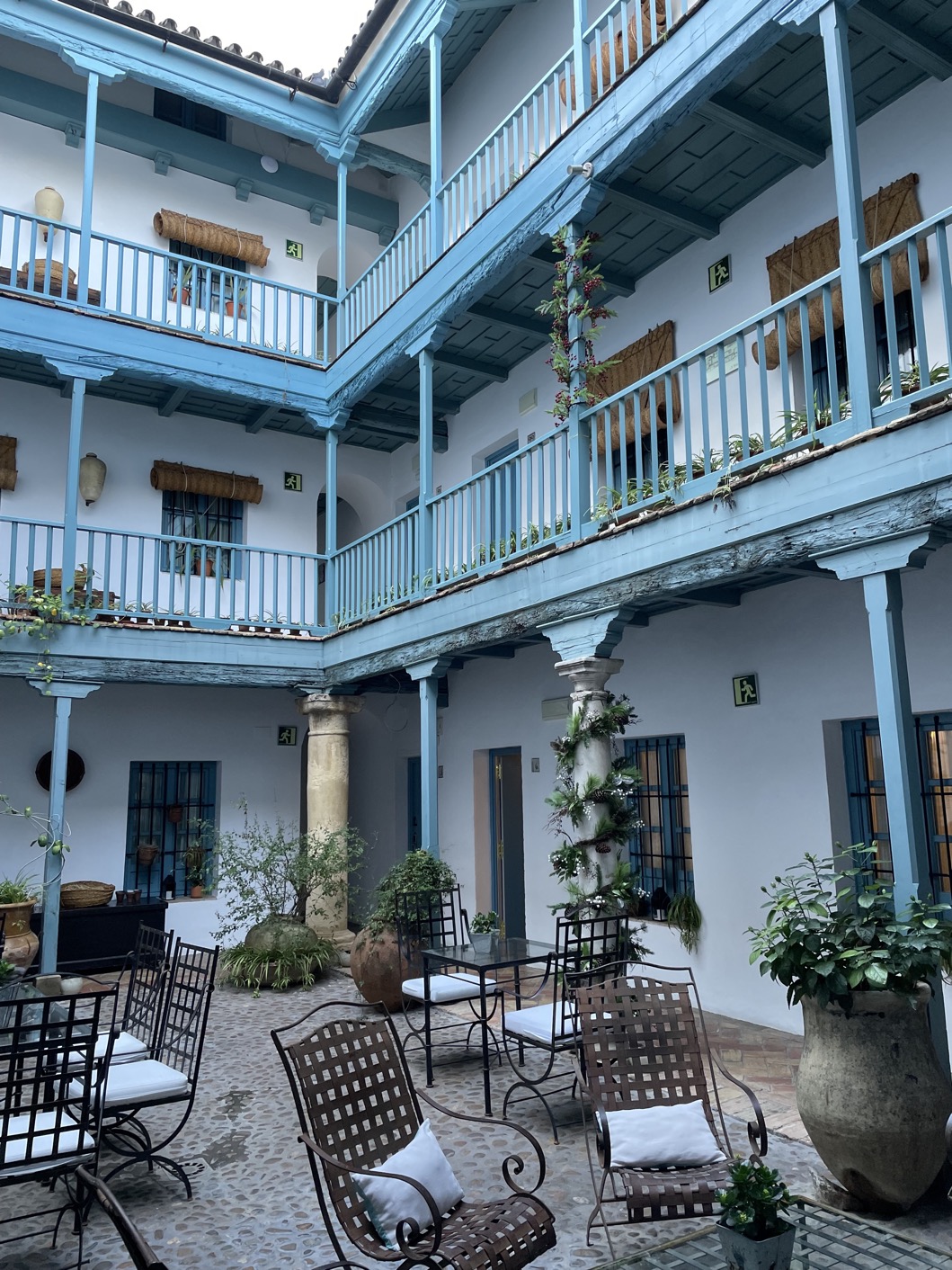
You can almost touch the traditional Spanish atmosphere in the courtyards and public rooms.
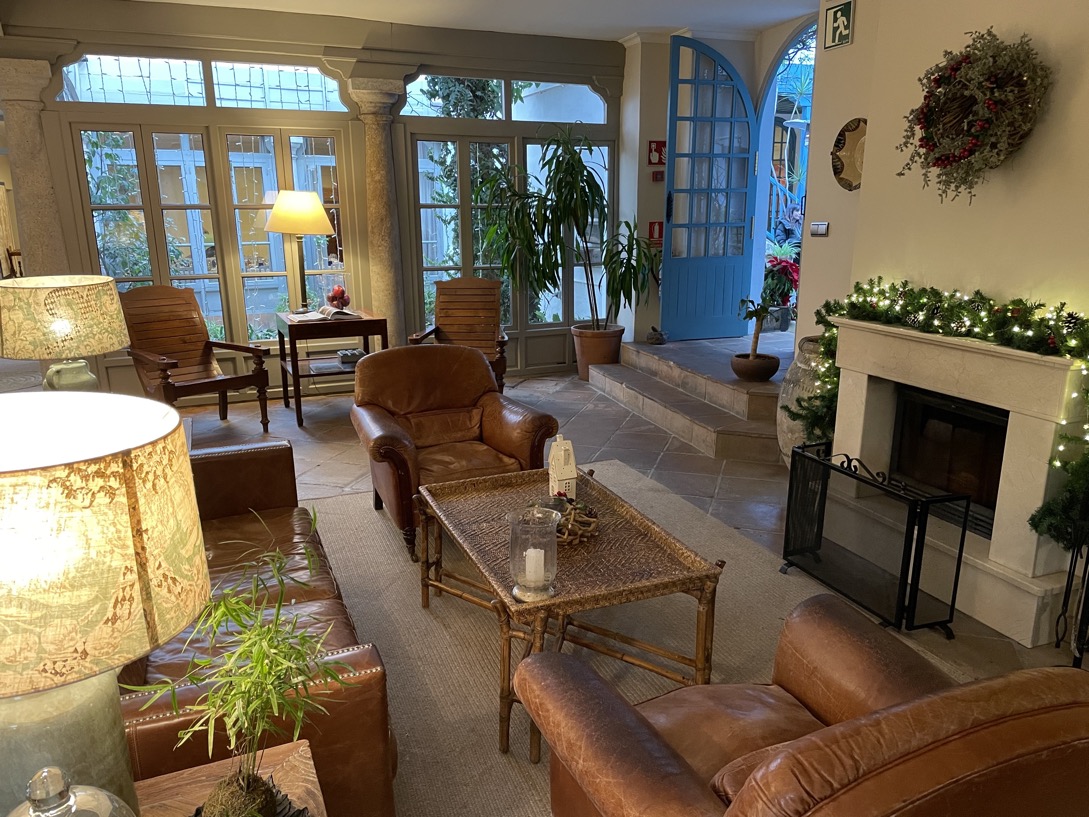
The hotel is in Barrio Santa Catalina in the district of the Casco Antiguo, the city centre. Firstly, Santa Catalina is a smallish area located in the extreme northeast of central Seville, but it still retains something of its medieval origins (it might have been considered a hamlet of Seville in those days). Historically the barrio was composed of singe-family homes, rather than tenements (although both were far more likely in Seville to be rented than owned). This would suggest that Santa Catalina was a neighbourhood of artisans, merchants and hoteliers (i.e. possibly what would be called the "urban wealthy" with numerous inns and lodging houses). Artisan is a general definition, but it would appear that Santa Catalina was popular with artisans working leather, wood, and ceramics, and the associated traders (i.e. those who transformed raw materials and who sold the products).
Given the presence of merchants and muleteers, inevitably there were two local markets (Ponce de León for horses and cattle, and Plaza de Santa Catalina for basics, e.g. wheat, etc.). It helped that the wheat gate to the city was through Santa Catalina (thus the important link with bread). Single-family houses were ideal for setting up workshops and shops. Even in 1554 Santa Catalina had 800 residents, which by any standards was a significant number even compared to cities such as Toledo or Córdoba, but Seville being what it was, Santa Catalina was only its 8th barrio by size. We can't forget that in the 16th century Seville expanded so rapidly that it equalled London, Venice, and Antwerp (just behind Paris and Naples). It's worth mentioning that perhaps as many as 20% of the merchants in Santa Catalina, traded merchandise to and from Seville (what might be considered today as specialist traders). The location of our hotel is not that far from Plaza de Santa Catalina, which was the focus for specialist professions and hospitality.
For Santa Catalina, and for Seville, immigration was the key. However, later Santa Catalina would also see the migration of merchants to the Americas. Early on Santa Catalina was one of the most commercial and productive areas of Seville, but over time its importance was diluted as it became increasingly residential.
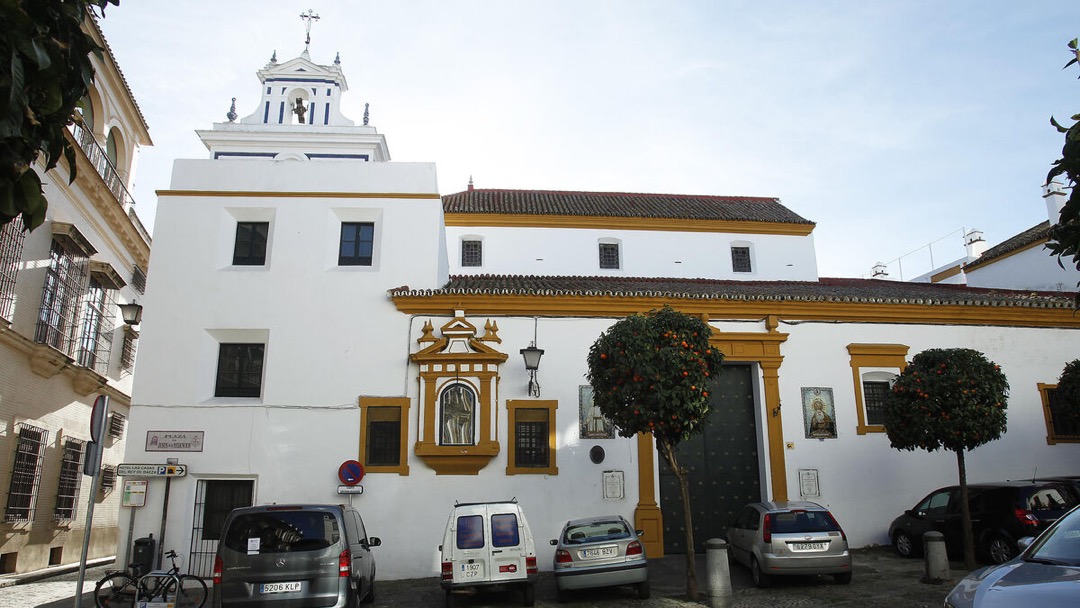
Located next to the hotel (hospes), in the Plaza de Jesús de la Redención (originally called Plaza de López Pintado), is the Iglesia de Santiago el Mayor, also known by the nickname of Santiago "el viejo". Unfortunately during our visit the church was closed for restoration, and the parking spaces closed (which made the plaza far less picturesque).
This church is the canonical headquarters of the Brotherhood of Redemption - Rocío, or to take its more formal title "Real e Ilustre Hermandad del Santísimo Sacramento y Cofradía de Nazarenos de Nuestro Padre Jesús de la Redención en el Beso de Judas, María Santísima del Rocío, Nuestra Señora del Carmen, San Fernando Rey y San Lucas Evangelista" (or Real and Illustrious Brotherhood of the Blessed Sacrament and Brotherhood of Nazarenes of Our Father Jesus of Redemption in the Kiss of Judas, Blessed Virgin del Rocio, Our Lady of Carmen, San Fernando Rey and San Lucas Evangelista). This brotherhood was formed in 1956, but only moved to this church in 1960. Its "images" date from 1955 to 1962, with the Kiss of Judas being the most symbolic (i.e. representing the moment when the apostle Judas betrayed the Lord with a kiss, which was the signal identifying Jesus to the Romans). The brotherhood claims around 3,650 members, of which around 1,350 are nazarenos (penitents) who wear white tunics with a purple velvet antifaz (mask).
This church itself in the times of Fernando III (1199-1252) represented an entire parish, but due to the depopulation of the area it became a subsidiary of the parish of San Ildefonso. It has a somewhat controversial past since the exact date of its construction is not known exactly. Various legends are told about its origins, among which, that the house of the Apostle Santiago used to stay in the place now occupied by the Church when he came to preach the Gospel, or that it is located on top of a Roman temple dedicated to the worship of the goddess Venus, or that it was a Visigoth church later transformed into a mosque, or that it became a synagogue and even that it was the palace of the Moorish king of Granada. The fact is that it has had so many renovations throughout its history that it is difficult to clearly determine an approximate date from the remaining stylistic features.
What is known is that the church was renovated/rebuilt in 1556 and that most of the renovations that we can observe today took place in the 17th and 18th centuries (e.g. the belfry in 1789). Remains from the 14th century are preserved in the area of the sacristy and its entry area, these remains being the brick domes with Mudéjar traces and ornaments. It is also noteworthy that in 1843 there was another renovation after three bombs fell on it, probably during the bombing that Seville suffered in July of that year just before Baldomero Espartero (1793-1879) embarked for exile in England. And finally, the last renovation took place between 1977 and 1980, in which the Mudejar coffered ceiling and the flooring were restored.
The on-going renovation includes a newly tiled roof and appeared to also involve the main façade and the belfry overlooking Plaza de Jesús de la Redención. Check out this webpage for a more extensive description of the church.
What I have tried to do is paint a picture of the history of area around the hotel, but I must admit I was less impressed with the reality. The streets are narrow, there were few or no shops, and it just appeared to be a place people drove, cycled, or walked through. Admittedly it's not far from some the major attractions in Seville, but those attractions appeared to not have "seeped" into the area of our hotel. The only intriguing feature in the area was the presence of Palacio Villapanés, a 5-star hotel just in front of our hotel. Booking tells us its a converted 18th century palace in Santa Cruz and not Santa Catalina, rated 9.0 (Superb) based upon 614 reviews. Prices appear to start at around €290 for a double with breakfast.
Our hotel Hospes Las Casas del Rey de Baeza was rated on Booking with an 8.9 (Fabulous) based upon 749 reviews, and on TripAdvisor it rated a 4.5 (Excellent) based upon 1393 reviews.
Our room
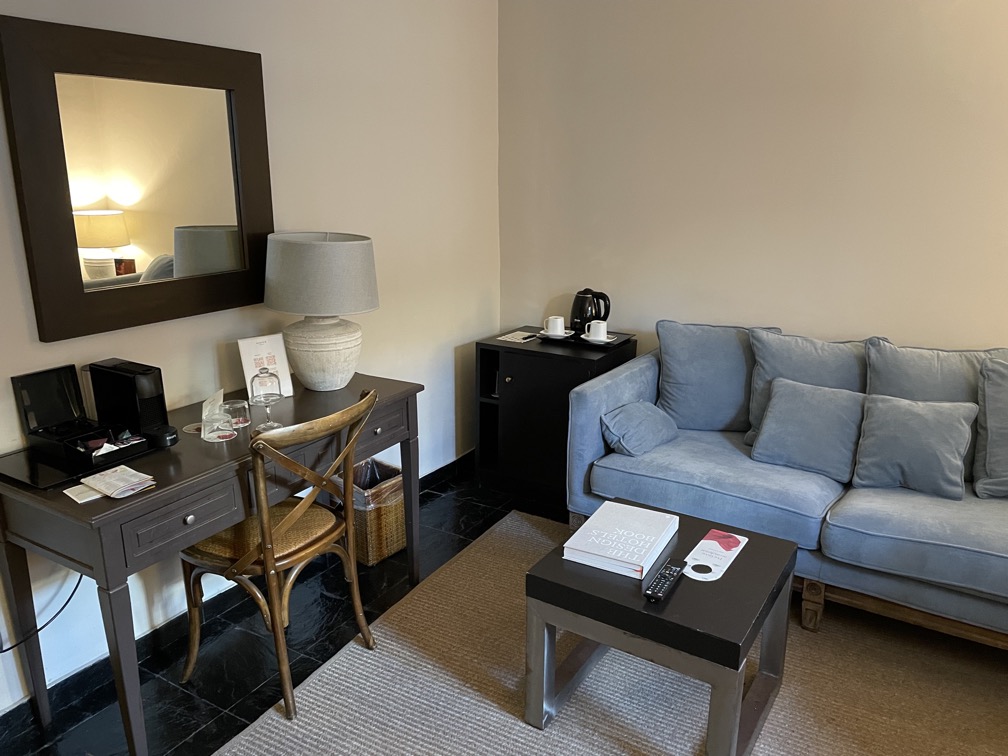
Our room turned out to be a suite with a sitting area, a bathroom area with separate bath, separate shower, and separate wardrobe area, and double hand basins, and a separate bedroom.
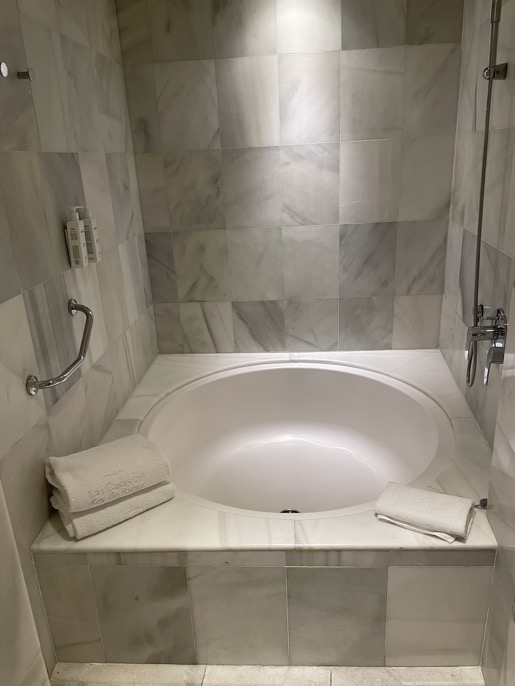
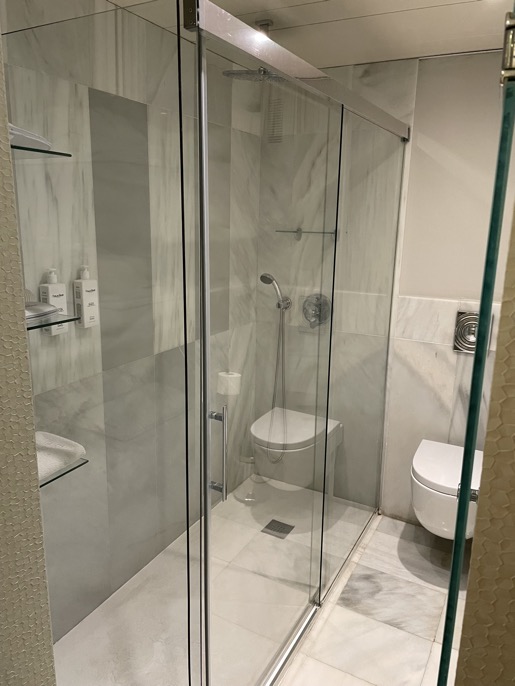
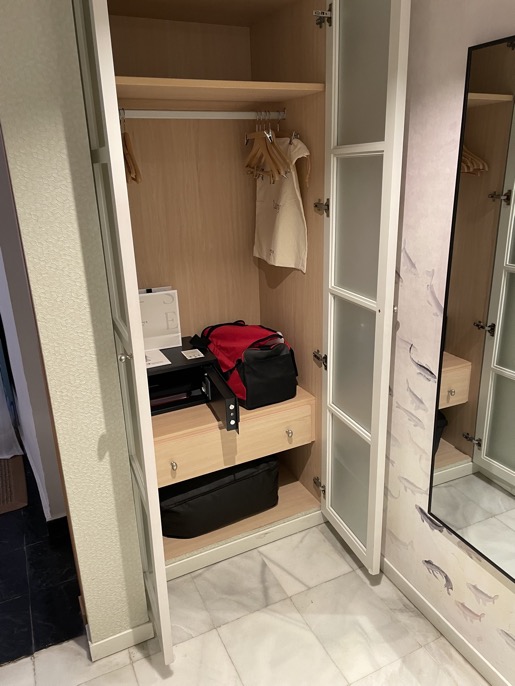
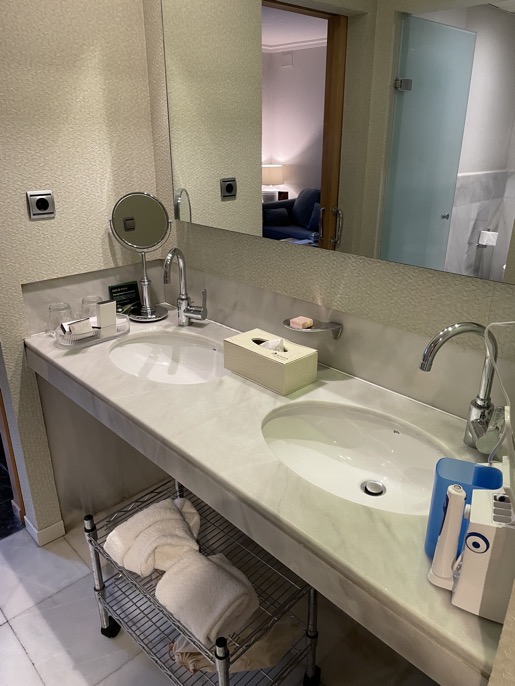
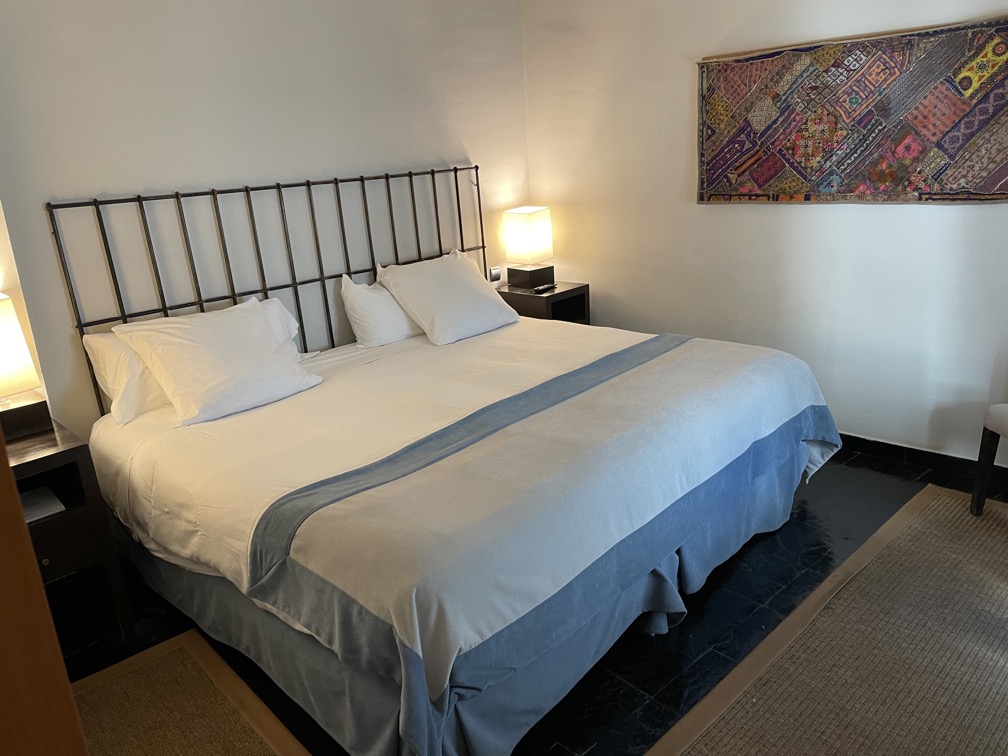
Nothing to complain about on the surface, except a perfectly boring room that could be anywhere in the world. Not what I expected having seen the courtyards, etc., nor what I expected from the photographs on the Internet.
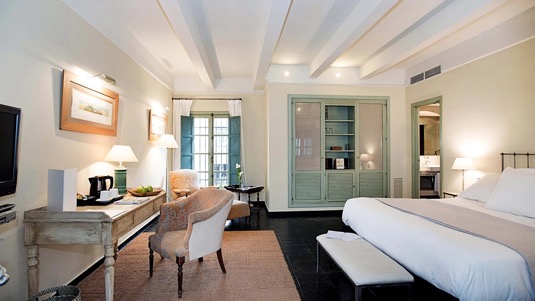
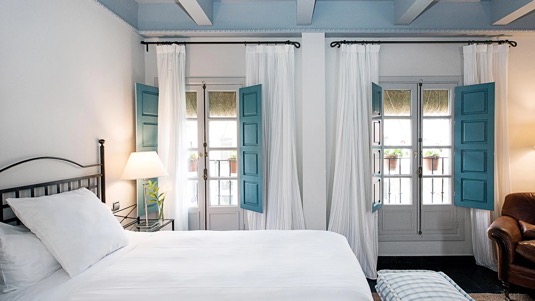
This may in part be due to our request for a walk-in shower, who knows.
Breakfast
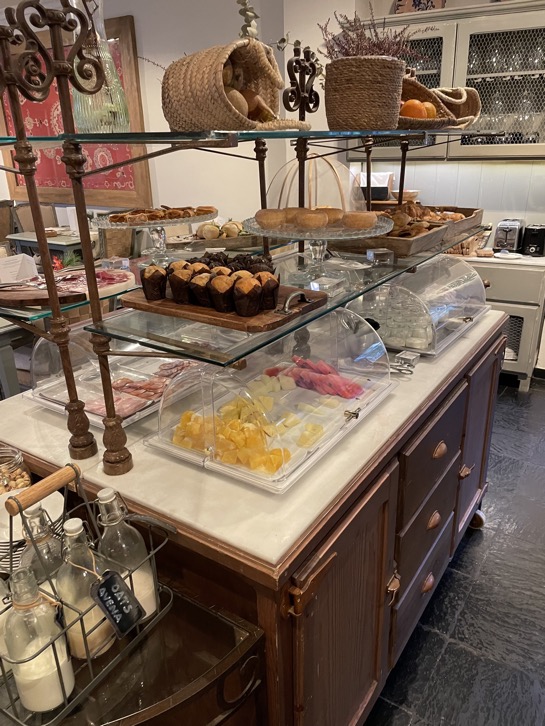
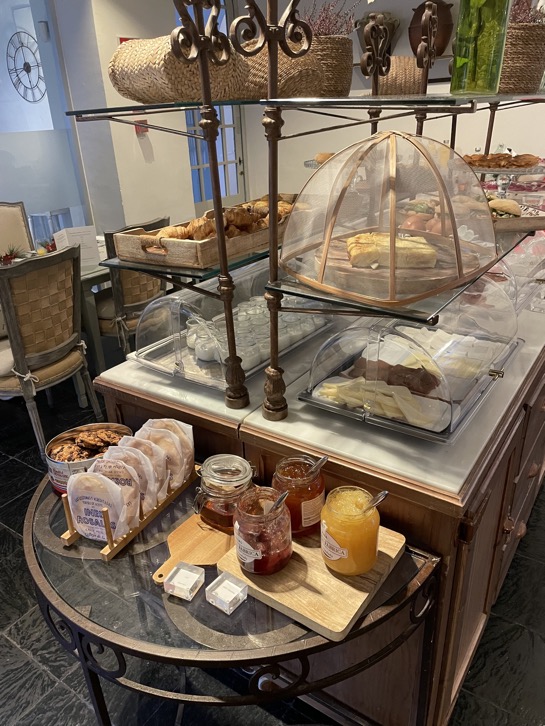
Breakfast was served in a smallish room next to the main entrance, however we always found a table and the service was efficient if not particularly friendly, Staff always seemed a little rushed, possible because of the limited space. Despite the limited space what was on offer was sufficient and there was an additional hot menu available (which we did not try).
Room service
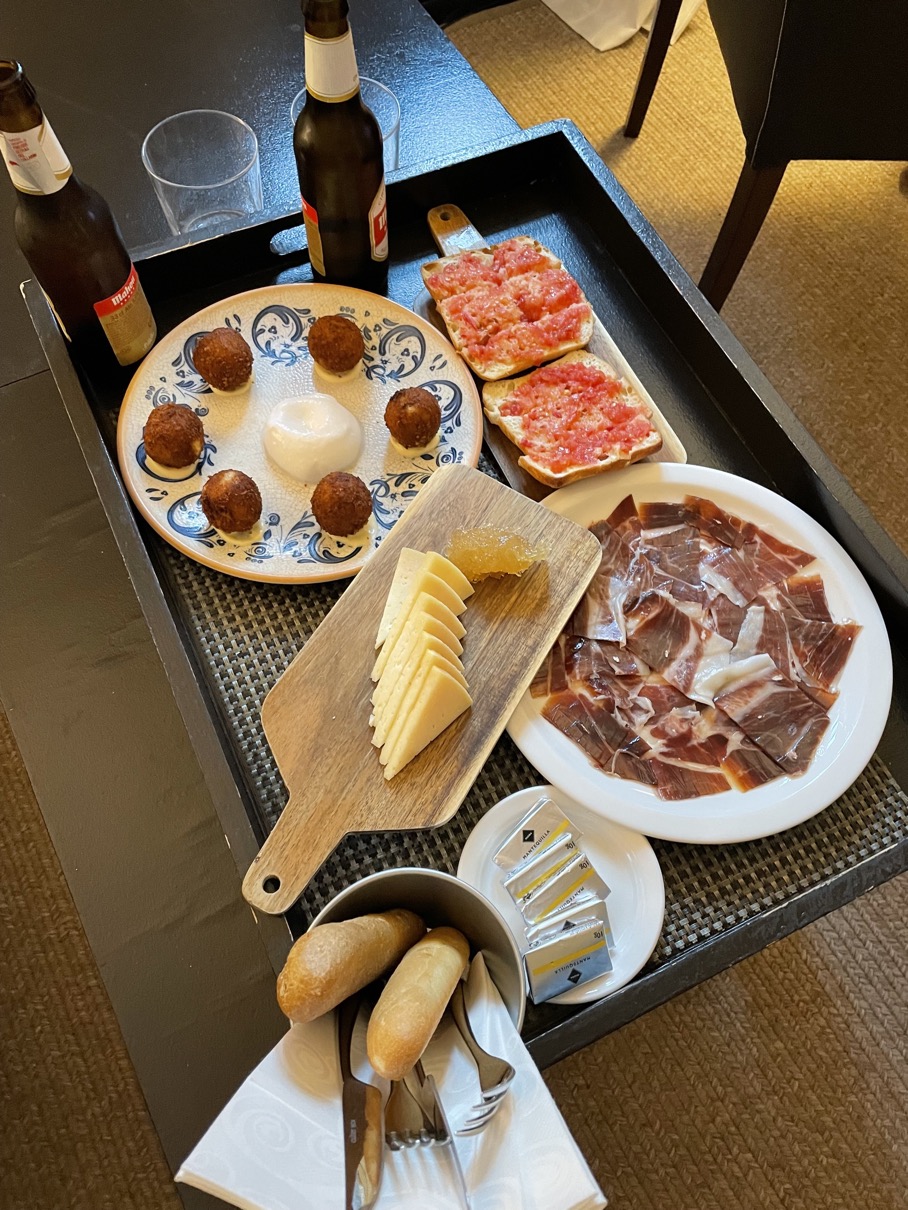
On our first evening we booked room service, and stuck to traditional Spanish foods, i.e. ham, cheese and croquetas, with a beer. All very tasty, in particular the Jamón Ibérico was really first class. After our Christmas Eve dinner on the 24th December, we went back to this same menu for the 25th December.
Dinner on the 24th December 2022
The full hotel Christmas Eve menu was:-
Copa de Champagne Taittinger Brut (Glass of Champagne Brut Taittinger)
Jamón Ibérico 100% bellota (100% acorn-fed Iberian ham)
Queso Añejo de leche cruda en AOVE (Aged raw-milk cheese in EVOO)
Terrina de foie, arándanos rojos y melaza de fondo de pato (Liver pate, cranberries and duck molasses)
Crema tostada de caza, manzana verde, namekos y yema de codorniz (Toasted cream, green apple, namekos and quail yolk)
Bacalao al horno, gazpachuelo de espárragos, calabaza asada y aire de algas (Baked cod, asparagus gazpachuelo, roasted pumpkin and seaweed air)
Presa Ibérica a las brasas con su jugo, parmentier con castañas y setas (Grilled Iberian pork with its own juices, parmentier with chestnuts and mushrooms)
Crema de limón y clavo, bizcocho de almendras y helado de galleta de jengibre (Lemon and clove cream, almond sponge cake and ginger biscuit ice cream)
Selección de Dulces Navideños (Selection of Christmas Sweets)
Agua, refrescos, cervezas y selección de café, té e infusiones (Water, soft drinks, beers and selection of coffee, tea and infusions).
The wines were:-
Vino Blanco - Marqués de Riscal D.O. Rueda
Vino Tinto XIII Lunas Reserva D.O. Ca. Rioja
The price was set at €95 IVA incluido (including VAT)
The first point to note was that the price is incredibly low for this type of Christmas Eve menu, a major warning sign! The New Year Eve menu was only €135, which was even more ludicrously low! But it must be said that many of these type of high-end hotel and resort menu's include cocktails, entertainment, discos, and an open bar.
In any case we are no longer able to sit and wait 2-3 hours and eat so many dishes, most of which are probably "not to our taste", i.e. a kind way to say that they are not worth waiting 2-3 hours to eat them.
The only redeeming feature of a Spanish Christmas Eve menu is that the staff want to finish early and go home to their family celebrations (which is certainly not the case for New Year Eve).
In any case were able to negotiate a limited Christmas Eve menu served in our room. This included:-
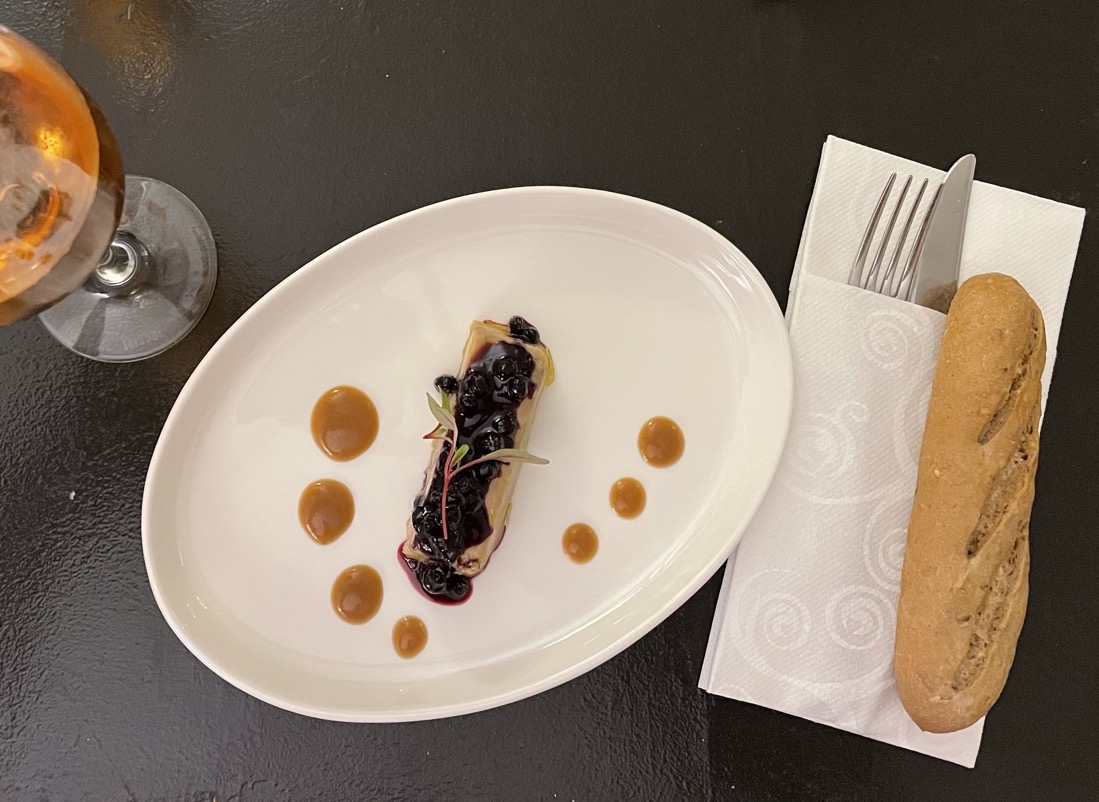
Terrina de foie, arándanos rojos y melaza de fondo de pato (Liver pate, cranberries and duck molasses).
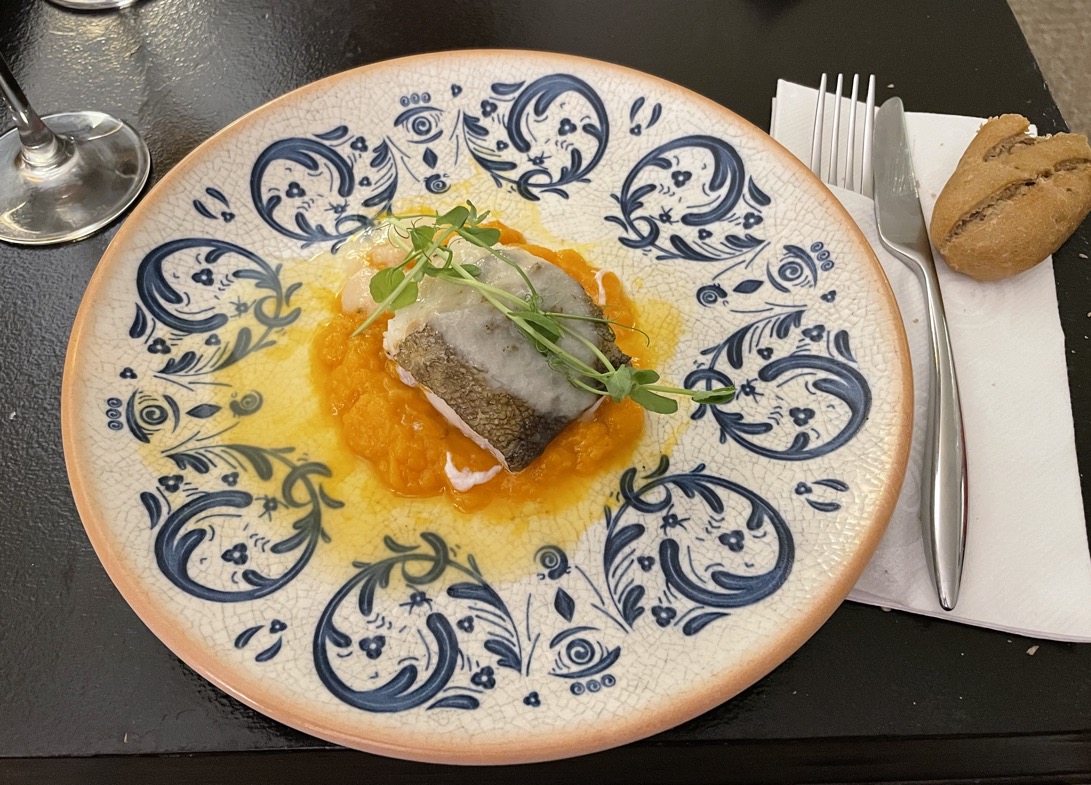
Bacalao al horno, gazpachuelo de espárragos, calabaza asada y aire de algas (Baked cod, asparagus gazpachuelo, roasted pumpkin and seaweed air).
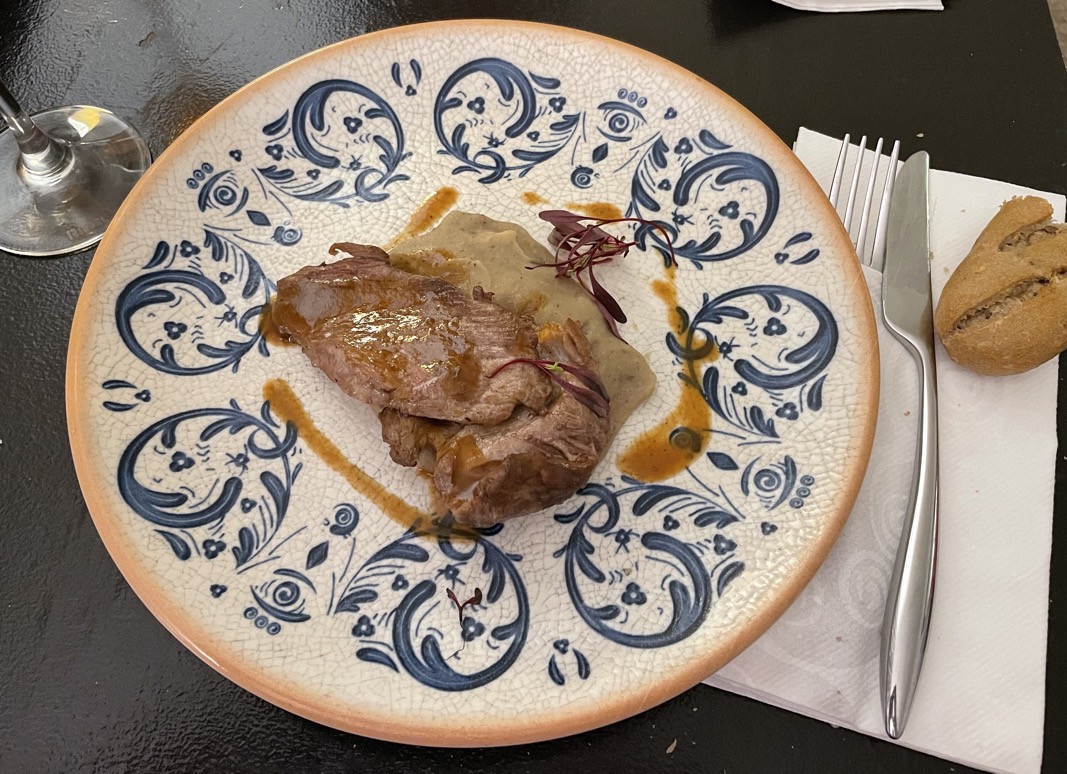
Presa Ibérica a las brasas con su jugo, parmentier con castañas y setas (Grilled Iberian pork with its own juices, parmentier with chestnuts and mushrooms).
And accompanied with a bottle of Bocchoris Rose Cava.
The liver pate was not bad, the cod was fine, and the Iberian pork was a waste of time (and energy). The Bocchoris Rose Cava was in fact very pleasant. It's a shame that the main dishes were served on cold plates, but a positive was that the Cava came in an ice bucket.
Before we move on, here is a bit more information on some of the more esoteric elements in our hotels Christmas Eve menu:-
It's still quite unusual for a 4-star Spain hotels to serve a glass of French Champagne, but I guess its all down to marketing clout.
Jamón Ibérico 100% bellota (100% acorn-fed Iberian ham). Spanish ham can be classified according to two different aspects, firstly the breed of pig from which the jamón is obtained and secondly the diet of the pigs. The breed of the pig is either a Jamón Serrano, which is called Gran Reserva (from the cerdo blanco) or a Jamón ibérico (from the Iberian pig). For the Iberian breed, the sow must be a 100% Iberian breed. If the boar is not Iberian, the jamón can only be considered 50% Iberian. When the sow and the boar are both 100% Iberian breeds, then the jamón is 100% Iberian breed. Concerning the feeding, only a 100% Iberian pig can be classified according to feeding, since the final quality may vary independently of the breed. For example the cerdo blanco (white pig) might follow the same diet, and the final flavour and texture could be similar to Jamón Ibérico, but much will depend on the quality of the feed offered and the care received from the rancher (ganadero). Iberian pigs can be feed from a commercial supplier, or left to feed naturally, or acorn fed. Also a lot depends not only the feed, but also the place where the pig has been raised during its different phases of growth. Ideally the best hams come from those pigs that have been carefully fattened by the montanera on an acorn diet (along with free-range grass, etc.). Pigs (cebo de campo) are those that have been feed fattened, but also left to graze naturally on wild grasses and fruit. Cebo de campo and acorn fed pigs are able to integrate fat into the muscle (its considered an innate gift), but the acorn diet and the exercise imposed on then by the montanera accentuates the integration process and results in a "juicer" and more aromatic jamón. Both types of ham can be quite juicy and aromatic, but is the bellota ham should taste more intense and yet melt in the mouth.
Queso Añejo de leche cruda en AOVE (Aged raw-milk cheese in EVOO). This just means a cheese that is cured in Aceite Oliva Virgen Extra (AOVE) or Extra Virgin Olive Oil (EVOO), and possibly matured for 6-12 months… It is often unpasteurised sheeps cheese.
Presa Ibérica is usually considered the best piece of pork, located between the head of the loin (lomo) and the shoulder (paleta). The idea is that because it is an area that moves a lot, the meat has fibre but is considered one of the tenderest and tastiest pieces
Selección de Dulces Navideños (Selection of Christmas Sweets) means turrón/nougats (mainly the traditional ones, soft or Jijona nougat and hard or Alicante nougat), polvorones, dates, marzipan, sugared almonds, alfajores, etc.
Rooftop pool
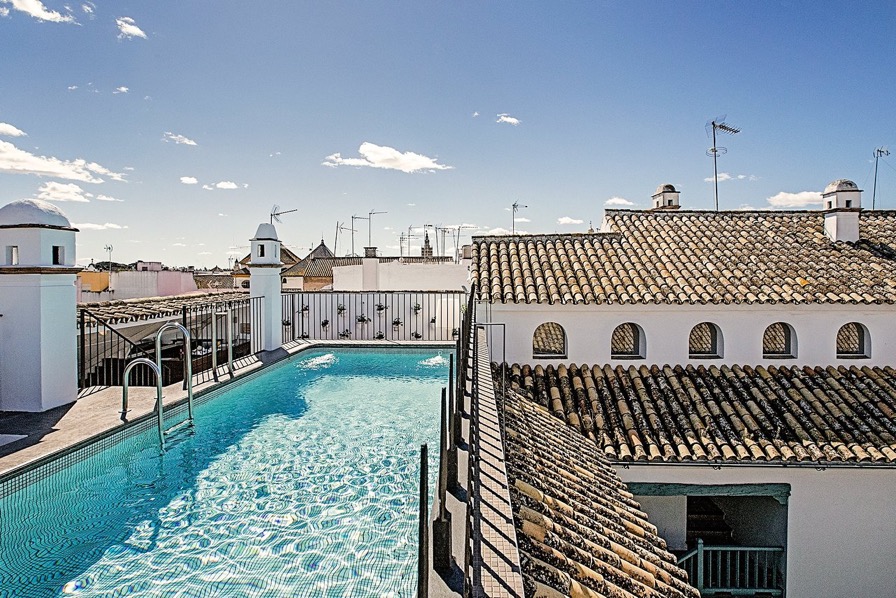
On the roof there is a smallish plunge pool, with some attractive poolside seating, which I'm sure in summer is much appreciated by hotel guests.
Overall conclusion
Positives were the way the staff were able to reply to all our needs, and their willingness to accept to provide room service on the evening of the 24th December.
However we were not that impressed by our Junior Suite itself, it lacked character, and at €430 per night with breakfast was over priced, even for Christmas in Seville. The quality of the food provided on the 24th December did not argue well the restaurant, but the standard fare of the room service was reasonable, and the breakfast was fine.
Over Christmas 2021 we booked a stay in the Hotel Gravina51, also in Seville. This hotel provided us a far superior experiences for a more competitive price. One that basis we would not return to the Hospes Las Casas del Rey de Baeza, nor recommend it.